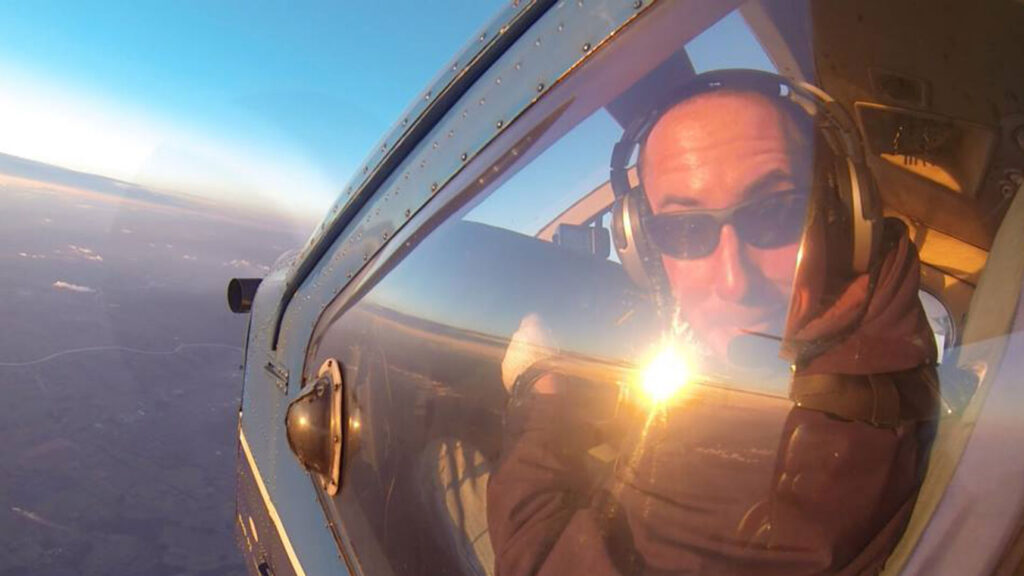Welcome to the second article by NFTO cameraman Simon Brentford!

Photo by Spencer Bailey
The first, So You Wannabe a Cameraflyer, describes how to begin filming skydiving
This second part is about how to specialise in your chosen area
By now, you’ve got a good handful of camera jumps and you’ll be wanting to know how to make some real progress into producing decent good quality footage. This is still a world away from perfect and that’s because we never stop learning; but getting some structure into your cameraflying is going to help you get invitations to events, earn a crust or enable you to join a team.
Tandem Camera
Let’s start with getting into Tandem Camera. For many, this is the “bread and butter” of earning a living in the sport. In the UK, you are required to have a minimum of 200 jumps, in France, it’s lower at 100. With all that variation around the world, it may take you a while to get the pre-requisite qualifications as well.
To begin, it is recommended to do a handful of follow-outs after the tandem, this allows you to get an understanding of how the hill looks and where the drogue will extend to. It can typically take anywhere from around 25-50 jumps to gain the skills. At my dropzone, Skydive Hibaldstow, they’re looking for consistency of footage, in addition to the close-up action shot. Most dropzones set their standards pretty high, as doing so maximises the experience, reduces disappointments and inspires others to book their first forays into the sport.

Photo: Tandem camera over Skydive Hibaldstow, by Kris Cavill
Here’s some of the key skills needed in this discipline:
Flying skills
Presenting a steep close up / underneath shot. Exits are considered the hardest part of the jump with the goal being not to get too much distance with the tandem. You will be expected to learn individual exit keys from the various instructors you work with.
Accuracy
Some dropzones will have a high-experience level landing area where only the tandems can land. If that is the case, you will need to wait and gain the jump numbers required. But if it’s an open landing area, being accurate to within 10 or 20 meters is going to help you make those back-to-back loads and capture the landing footage.
Social skills
At the start and end of every tandem, you will need to employ some serious Terry Wogan style interviewing skills.
Photography
Taking high quality shots in mixed-light conditions takes a while to get right. Most use a separate SLR camera, but some also use a GoPro in stills mode.
Safety
Exit timing is important as no-one wants you to get hit by the drogue.
Editing
The last thing to say is that many dropzones use specialist pre-built tandem editing software where you submit a sequence of 6 to 8 different sequences from throughout the jump and this is then automatically edited for you. However, many dropzones don’t use this software, so you will need to learn to edit.
Your first camera suit should probably be a camera jacket with wings. This allows you to fly steeply so that you can look up and underneath the tandem. I can remember filming a friend with their 14-year-old daughter. They must have had a combined weight of less than 90kg. I could only just stay with them wearing a camera suit going less than 100mph! Personally, I fly TonySuit which gives me a massive range and is pretty hard-wearing.

Formation Skydiving Teams
As you might guess, I love FS camera in all its forms – 4-way, 8-way and bigway. I never get bored and I’ve had the privilege of witnessing many unique and special moments in freefall. I’m a part of the British 4-way team, NFTO and have been lucky enough to win a few medals here and there.
If you think that team life is your thing, then I’d start with a Rookie or single A class 4-way. Trying to find a local 4-way team is a good way to start and even if you can’t find one, there is nothing to stop you building your own. I’ve done it more than once. Enter some of your regional competitions and National Championships. They are so much fun and there will be plenty of talented cameraflyers and judges willing to offer their expertise.
Here’s a few general tips:
- Prepare – Spend some extra time on the ground learning about exit timing in the airplane mock-up.
- Ringsight – Get a ringsight or at least put a mark on your goggles / visor, so you can really hone where your camera is looking.
- Watch Video – Find some videos of the top teams you can find. What is it that makes their camera flyers good? Are you leaving with the team, going after? How steep above can you fly? Do they stay still?
- Train – Look for a team that is planning to do at least 30 training jumps during the season leading up to your competition.
- Mind the Gap – Many cameraflyers are worried about hitting their team and this causes them to go too early or too late. Here’s a link to an article titled Mind the Gap which might help.
- Do your Homework – Learn the formations by letter and number. Keep notes on each formation – eg, goes steep out the door, keys fast, drops midway through the block, ask Outside Centre to present left hand more, etc.

Photo: Spencer Bailey filming big-way at Hibaldstow, by Alex Potter
Bigway
If bigway is your thing, sign up for as many low experienced weekend events as you can. Anything ranged between a 6-way and a 12-way will help. After you’ve learned the basics, there is a whole world waiting from multi-plane action to boogies abroad and beautiful photography.

Image by Airwax Freefly
Freefly / Tracking
There are many disciplines in freefly from small groups, to freestyle, tracking and bigways. It’s common place for freeflyers to shoot video, even if they are not designated as the cameraflyer for that jump. In fact at the recent head-up world record, some 69 out of the 76 jumpers involved wore camera.
That being said, if creating or shooting video and taking high-quality photos is your ‘bag’, there are lots of opportunities.
A good place to start is to consider how you fly relative to a formation. If you are constantly drifting in and out from your group, the footage is never going to look good.

Image by Ewan Cowie
General tips:
- Stay still – Learn to be able to look around without it affecting your body position. It’s common for new camera flyers to cork / pop up when changing who they are looking at.
- Fly the Exit – Flying the exit in either head up or head down position and exiting facing the tail, line of flight or any other angle, will take a great many jumps to become consistent at.
- Tunnel training – Go to the tunnel and practice rotating from back to sit and from belly to sit. You are going to need to this. Equally, knowing how to transition from head up to head down whilst maintaining eye-contact with a mark on the tunnel wall.
- Talk to the judges – If you are planning to get into the freestyle or freefly competition scene, there can be a lot of subjectivity as regards scoring and this can lead to disappointment. Finding a friendly judge and an experienced freefly competitor can make a huge difference. It’s all about showing what the judges regard as being technical, artistic and flowing.

Image: World Champion freestylist Yohan Abby and cameraflyer Will Penny
Safety
Safety has its idiosyncrasies. For starters, it’s much easier to lose altitude awareness on a freefly jump, so make sure you are wearing an audible (or two!). Likewise, it’s also commonplace to lose people vertically and this is particularly relevant on small group, low-experience, weekend freefly jumps. Having a natural awareness of where everyone is, will make a difference to both safety and being in the right place to capture your video.
Mentorship

Image at Skydive Hibaldstow by Martin Skrbel
With all the types of camera mentioned above (and there are plenty of others not discussed), having a friendly, knowledgeable expert to mentor you is going to make you a better jumper, much faster. Considering you will have around 200 jumps, I’m going to assume you’ve made some friends already.
Progression in FS or FF can be a seriously expensive thing with highly-structured coaching camps and day rates. However, I’ve only ever seen a few camera coaching courses and know little about them. Nonetheless, if you can find an expert who is willing to mentor, go for it and be prepared to offer some compensation (even if they don’t ask for anything).
Make sure your coach is flexible enough to work around you and help you find your style. It’s a myth that there is a “right” way to film, we all have significantly different styles. There is so much variation in technique from camera step foot placement, to filming angles, timing, synchronicity, hill work, jumpsuits, camera equipment, visualisation, etc. To summarise a good coach, they are there to present the options and help you develop your style.

Photo: Spencer Bailey loving filming bigways at Hib
Enjoy Your Work and Have Some Fun

Photo: Bruce Griffith
For me flying camera has always given me an immense amount of pleasure. I feel connected to my team and it’s a highly creative process.
For sure you are going to have some rocky moments. I’ve pretty much had them all – camera malfunctions, hitting the team, missing the points, being poor. Yet despite that, I wouldn’t have missed a moment of it.
I want to end this article with an extraordinary external video of Dan Guest filming Jamie Arnold a few years back. It shows how hard camera flyers have to work and are far from just being passengers. Enjoy.
Video: Dan Guest and Will Penny
showing the outside perspective for freestyle
Many thanks to Gary Crisp, Rob Jons and Benjamin Reed-Smith for invaluable input to this article – Simon
Working in Skydiving Series

Here are other articles aimed to help you work in your chosen area of the sport:


